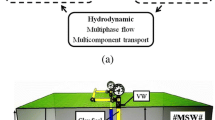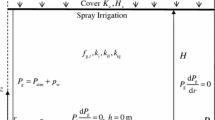Abstract
Aeration by airflow technology is a reliable method to accelerate waste biodegradation and stabilization and hence shorten the aftercare period of a landfill. To simulate hydro-biochemical behaviors in this type of landfills, this study develops a model coupling multi-phase flow, multi-component transport and aerobic-anaerobic biodegradation using a computational fluid dynamics (CFD) method. The uniqueness of the model is that it can well describe the evolution of aerobic zone, anaerobic zone, and temperature during aeration and evaluate aeration efficiency considering aerobic and anaerobic biodegradation processes. After being verified using existing in situ and laboratory test results, the model is then employed to reveal the bio-stable zone development, aerobic biochemical reactions around vertical well (VW), and anaerobic reactions away from VW. With an increase in the initial organic matter content (0.1 to 0.4), the bio-stable zone expands at a decreasing speed but with all the horizontal ranges larger than 17 m after an intermittent aeration for 1000 days. When waste intrinsic permeability is equal or greater than 10−11 m2, aeration using a low pressure between 4 and 8 kPa is appropriate. The aeration efficiency would be underestimated if anaerobic biodegradation is neglected because products of anaerobic biodegradation would be oxidized more easily. A horizontal spacing of 17 m is suggested for aeration VWs with a vertical spacing of 10 m for screens. Since a lower aeration frequency can give greater aeration efficiency, a 20-day aeration/20-day leachate recirculation scenario is recommended considering the maximum temperature over a reasonable range. For wet landfills with low temperature, the proportion of aeration can be increased to 0.67 (20-day aeration/10-day leachate recirculation) or an even higher value.













Similar content being viewed by others
References
ANSYS (2009) ANSYS Fluent 12.0 user’s guide. Canonsburg, PA: ANSYS
Cao BY, Feng SJ, Li AZ (2018) CFD modeling of anaerobic-aerobic hybrid bioreactor landfills. Int J Geomech 18:04018072
Feng SJ, Lu SF, Chen HX, Fu WD, Lü F (2017a) Three-dimensional modelling of coupled leachate and gas flow in bioreactor landfills. Comput Geotech 84:138–151
Feng SJ, Gao KW, Chen YX, Li Y, Zhang LM, Chen HX (2017b) Geotechnical properties of municipal solid waste at Laogang Landfill, China. Waste Manag 63:354–365
Feng SJ, Cao BY, Li AZ, Chen HX, Zheng QT (2018) CFD modeling of hydro-biochemical behavior of MSW subjected to leachate recirculation. Environ Sci Pollut Res 25:5631–5642
Fytanidis DK, Voudrias EA (2014) Numerical simulation of landfill aeration using computational fluid dynamics. Waste Manag 34:804–816
Grisey E, Aleya L (2016) Prolonged aerobic degradation of shredded and pre-composted municipal solid waste: report from a 21-year study of leachate quality characteristics. Environ Sci Pollut Res 23(1):800–815
Haarstrick A, Mora-Naranjo N, Meima J, Hempel DC (2004) Modeling anaerobic degradation in municipal landfills. Environ Eng Sci 21(4):471–484
Hrad M, Huber-Humer M (2017) Performance and completion assessment of an in-situ aerated municipal solid waste landfill—final scientific documentation of an Austrian case study. Waste Manag 63:397–409
Hubert J, Liu X, Collin F (2016) Numerical modeling of the long term behavior of municipal solid waste in a bioreactor landfill. Comput Geotech 72:152–170
Kim SY, Tojo Y, Matsuto T (2007) Compartment model of aerobic and anaerobic biodegradation in a municipal solid waste landfill. Waste Manag Res 25:524–537
Ko JH, Powell J, Jain P, Kim H, Townsend T, Reinhart D (2013) Case study of controlled air addition into landfilled municipal solid waste: design, operation, and control. J Hazard Toxic Radioact Waste 17:351–359
Lavagnolo MC, Grossule V, Raga R (2018) Innovative dual-step management of semi-aerobic landfill in a tropical climate. Waste Manag 74:302–311
Liu L, Ma J, Xue Q, Wan Y, Yu X (2018a) Modeling the oxygen transport process under preferential flow effect in landfill. Environ Sci Pollut Res 25:18559–18569
Liu L, Ma J, Xue Q, Shao J, Chen Y, Zeng G (2018b) The in situ aeration in an old landfill in China: multi-wells optimization method and application. Waste Manag 76:614–620
McDougall J (2007) A hydro-bio-mechanical model for settlement and other behaviour in landfilled waste. Comput Geotech 34:229–246
Nag M, Shimaoka T, Komiya T (2018) Influence of operations on leachate characteristics in the aerobic-anaerobic landfill method. Waste Manag 78:698–707
Ng CWW, Feng S, Liu H (2015) A fully coupled model for water-gas-heat reactive transport with methane oxidation in landfill covers. Sci Total Environ 508:307–319
Omar H, Rohani S (2017) The mathematical model of the conversion of a landfill operation from anaerobic to aerobic. Appl Math Model 50:53–67
Öncü G, Reiser M, Kranert M (2012) Aerobic in situ stabilization of landfill Konstanz Dorfweiher: leachate quality after 1 year of operation. Waste Manag 32:2374–2384
Park JK, Chong YG, Tameda K, Lee NH (2018) Methods for determining the methane generation potential and methane generation rate constant for the FOD model: a review. Waste Manag Res 36:200–220
Powell J, Jain P, Kim H, Townsend T, Reinhart D (2006) Changes in landfill gas quality as a result of controlled air injection. Environ Sci Technol 40:1029–1034
Powrie W, Beaven R (1999) Hydraulic properties of household waste and implications for landfills. Proc Inst Civ Eng Geotech Eng 137:235–237
Raga R, Cossu R (2014) Landfill aeration in the framework of a reclamation project in Northern Italy. Waste Manag 34:683–691
Raga R, Cossu R, Heerenklage J, Pivato A, Ritzkowski M (2015) Landfill aeration for emission control before and during landfill mining. Waste Manag 46:420-429
Reddy KR, Hettiarachchi H, Parakalla N, Gangathulasi J, Bogner J, Lagier T (2009) Hydraulic conductivity of MSW in landfills. J Environ Eng 135:677–683
Reddy KR, Kulkarni HS, Khire MV (2012) Two-phase modeling of leachate recirculation using vertical wells in bioreactor landfills. J Hazard Toxic Radioact Waste 17:272–284
Reichenberger V, Jakobs H, Bastian P, Helmig R (2006) A mixed-dimensional finite volume method for two-phase flow in fractured porous media. Adv Water Resour 29:1020–1036
Ritzkowski M, Stegmann R (2012) Landfill aeration worldwide: concepts, indications and findings. Waste Manag 32:1411–1419
Ritzkowski M, Stegmann R (2013) Landfill aeration within the scope of post-closure care and its completion. Waste Manag 33:2074–2082
Ritzkowski M, Walker B, Kuchta K, Raga R, Stegmann R (2016) Aeration of the teuftal landfill: Field scale concept and lab scale simulation. Waste Management 55:99-107
Stoltz G, Gourc JP, Oxarango L (2010) Liquid and gas permeabilities of unsaturated municipal solid waste under compression. J Contam Hydrol 118:27–42
Townsend TG, Powell J, Jain P, Xu Q, Tolaymat T, Reinhart D (2015) Sustainable practices for landfill design and operation. Springer, New York
Tran HN, Münnich K, Fricke K, Harborth P (2014) Removal of nitrogen from MBT residues by leachate recirculation in combination with intermittent aeration. Waste Manag Res 32:56–63
White J (2008) The application of LDAT to the HPM2 challenge. Proceedings of the Institution of Civil Engineers-Waste and Resource Management Thomas Telford Ltd, pp. 137-146
White J, Zardava K, Nayagum D, Powrie W (2015) Functional relationships for the estimation of van Genuchten parameter values in landfill processes models. Waste Manag 38:222–231
Notations
\( \overset{=}{\tau } \)shear stress tensor
Aanisotropy of MSW
Dimass diffusion coefficient for component i
DT,ithermal diffusion coefficient
fTinhibition factor of temperature
fθinhibition factor of moisture content
gacceleration of gravity
H0landfill height
Hsscreen length of VW
HwVW depth
hqspecific enthalpy of phase q
\( \overrightarrow{J_i} \)diffusion flux of component i
kiintrinsic permeability
k•Monod saturation constant
kO2,isaturation constant of O2
kCH4saturation constant for CH4
krrelative permeability
K•reaction rate constant
mvgvan Genuchten constant
ntotal porosity of MSW
nvgvan Genuchten constant
pqliquid/gas pressure
pccapillary pressure
\( {P}_{{\mathrm{O}}_2} \)partial pressure of O2
PH2partial pressure of H2
PCH4partial pressure of CH4
qqheat flux
Qpqintensity of heat exchange between phases
\( {R}_{\bullet}^i \)reaction rate
Risource/sink term of component i in biochemical reactions
\( {R}_{\bullet}^{\mathrm{D}} \) decay rate of biomass
Siconcentration of substrate
Seeffective degree of saturation
Sqsource/sink term of phase q
ttime
Ttemperature
Vqvolume occupied by phase q
\( \overrightarrow{v_q} \)velocity of phase q
X•concentration of biomass
\( {X}_{\bullet}^{ini} \)initial concentration of biomass
Yimass fraction of component i in phase q
Y•yield coefficient
αlrresidual volume fraction of leachate phase
αlsmaximum volume fraction of leachate phase
αqphasic volume fraction of phase q
αvgVGM parameter related to the gas entry pressure
μqdynamic viscosity of phase q
μ•specific growth rate of biomass
\( {\mu}_{\bullet}^{\mathrm{max}} \)maximum specific growth rate
η•environmental inhibition factor
ρqdensity of phase q
Funding
The work was supported by the National Natural Science Foundation of China under Grant Nos. 41725012, 41572265, and 41661130153; the Shuguang Scheme under Grant No. 16SG19; and the Newton Advanced Fellowship of the Royal Society under Grant No. NA150466.
Author information
Authors and Affiliations
Corresponding author
Additional information
Responsible editor: Marcus Schulz
Publisher’s note
Springer Nature remains neutral with regard to jurisdictional claims in published maps and institutional affiliations.
Rights and permissions
About this article
Cite this article
Feng, SJ., Li, AZ., Zheng, QT. et al. Numerical model of aerobic bioreactor landfill considering aerobic-anaerobic condition and bio-stable zone development. Environ Sci Pollut Res 26, 15229–15247 (2019). https://doi.org/10.1007/s11356-019-04875-y
Received:
Accepted:
Published:
Issue Date:
DOI: https://doi.org/10.1007/s11356-019-04875-y




